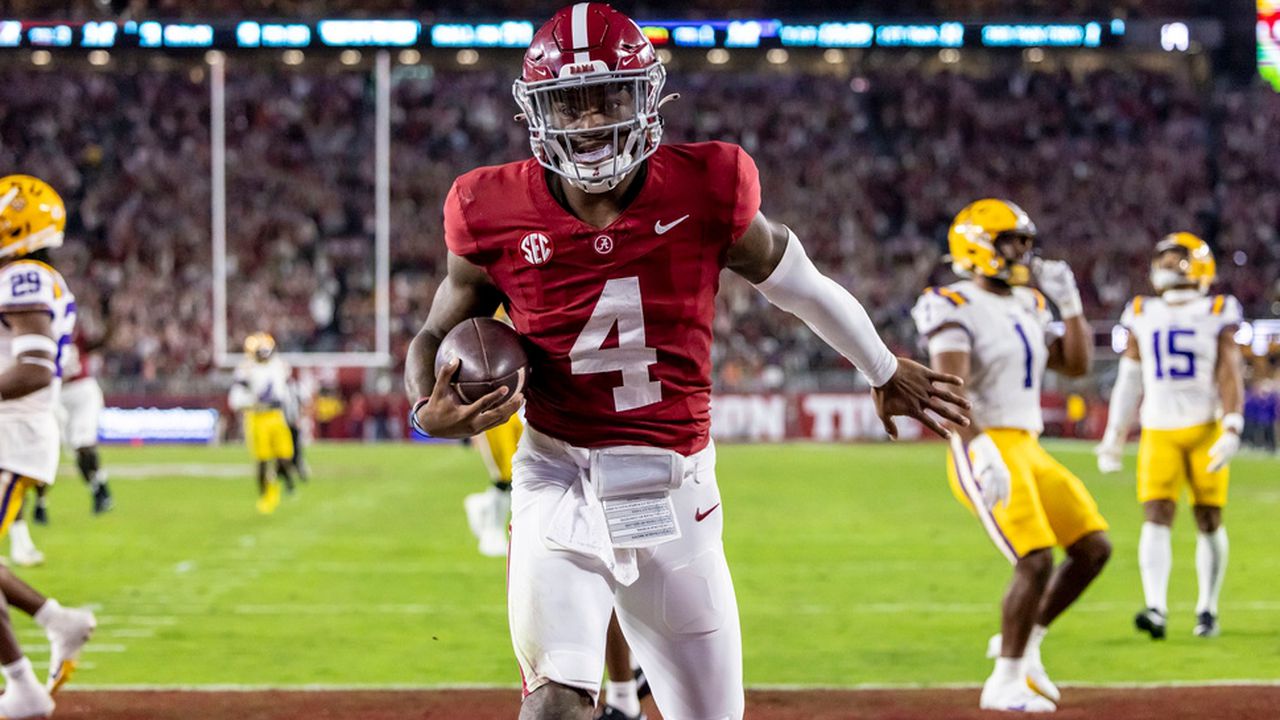The factor that beat LSU and saved Alabamaâs season
There was a lot to consider in the aftermath of Saturday night in Bryant-Denny Stadium.
The 42-28 Alabama win over LSU had a little bit of everything from an in-game dash of controversy to a postgame hot mic. These two know nothing about playing a boring 60 minutes of conventional football and may that never change.
There’s one number, however, that keeps smacking me in the face as an overwhelmingly important factor in a two-touchdown game. It’s one on a lengthy table in the box score but feels among the most significant separators of winners and losers.
Alabama faced 14 third downs under the lights with its season again dangling above a snake pit. Only once this season had they faced more.
Of those 14, Jalen Milroe and Co., converted 11.
That’s a 78.6% hit rate that’s hardly common — efficiency on an evening Alabama needed it the most. Not only did it keep LSU’s top-ranked and clearly effective offense waiting a little longer but it meant points on the scoreboard.
No, this wasn’t the quick-strike, bombs-away offense that bettered the Tigers. It was about sustaining drives.
And this situational success was crucial enough to be mentioned in the fifth sentence of Nick Saban’s postgame news conference opening statement.
“Our offense controlled the tempo of the game, especially in the second half, and I think that was the difference in the game — having over 500 yards of offense,” he said, “but the key to it was being 11-of-14 on third down and being able to keep the ball, which kept it away from them, which was a real key.”
According to our research, Alabama hasn’t converted 78.6% of third downs (minimum of 10 attempts) since the 2012 Iron Bowl win over Auburn. Alabama’s been among the nation’s top three in third-down conversions four seasons since and was No. 1 in 2020 but didn’t have a game as efficient as Saturday’s in nearly 11 seasons.
And when you score touchdowns on six of the nine drives outside of end-of-half situations, you’re going to need to pick the correct fork in those third-down roads.
Alabama’s three losses from the past two seasons speak to that. The Tide was a combined 17-for-43 (or 39.5%) when losing to Tennessee (6-for-13) and LSU (6-for-16) last fall and Texas (5-for-14)in September.
Convert one or two here or there and those could have been stories that ended like Saturday’s.
Zoom out and the importance of this stat comes into focus. Three of the top-six teams in the AP poll — Michigan, Oregon and Georgia — are among the top four teams in conversion percentage. Alabama is up to No. 6 in the FBS with a season percentage of 47.7%
Look deeper at how Alabama was so efficient on third downs and the picture comes into focus.
They converted all three third downs needing nine-plus yards — each Jalen Milroe scrambles including a 21-yard touchdown run.
Milroe was also a perfect 5-for-5 for 93 passing yards when that was a better option. Context is important there.
Twice Milroe hit running backs for huge gains on third down plays.
The first was a true improvision when a third-and-8 pocket broke down. Instead of running through traffic, he flicked a pass just as a tackler arrived. Jase McClellan took it 42 yards.
A few minutes later, Milroe floated a third-and-3 pass just over the fingertips of star linebacker Harold Perkins to the outstretched hands of Jamarion Miller. The sophomore took it 35 yards to the LSU 32, setting up Milroe for his 21-yard touchdown scramble (on third-and-9) just before halftime.
There was a confidence and comfort within the scheme on each of these plays that helped Alabama keep pace with LSU’s torrid first-half offensive pace.
It’s notable because this didn’t start out as smoothly. After connecting with tight end CJ Dippre for 11 yards on the game’s first third down, Milroe was sacked on the next one in a scene all too familiar from the first eight games of the season. That brought James Burnip off the bench for what would ultimately be his only punt of the night after averaging 5.0 a game previously.
The only other two failed third-down conversions came in what’s typically a safe zone. Both came inside the LSU 30-yard line, summoning Will Reichard who hadn’t missed a field goal all season. Of course that’s the asterisk in the story since the normally-automatic senior kicker missed both long field goals following the other two failed conversions.
Otherwise, Alabama’s much-ridiculed offense was nearly spotless in the biggest moments. They aren’t all moments for videoboard montages and dramatic moments. Most were fairly routine.
But add them up and it was probably the biggest difference between winning and losing on a night Alabama couldn’t afford the latter.
Michael Casagrande is a reporter for the Alabama Media Group. Follow him on Twitter @ByCasagrande or on Facebook.
